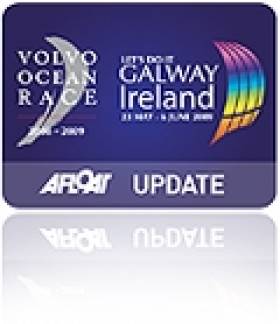Displaying items by tag: Feargal Kinsella
#VOLVO OCEAN RACE - Former Paralympic sailor and Irish National Helmsman’s Champion Feargal Kinsella will realise the dream of a lifetime when he sails on a round-the-world racing yacht in Galway as part of the Volvo Ocean Race festivities tomorrow Saturday 7 July.
The story of Feargal’s triumph over physical disability has touched the hearts of millions in recent radio and television interviews, and tomorrow morning he will finally get to fulfill one of the ten things he most wants to do in life.
"I just want to get my hands on the helm of one of the fastest and most powerful sailing boats in the world and I am absolutely thrilled that I may be able to do that on Saturday when I will join the crew of the Green Dragon on Galway Bay.”
The Green Dragon was the Chinese-Irish entry in the last Volvo Ocean Race and as part of the festival organised around the arrival of the VOR fleet in Galway, Feargal has been invited to sail it on the bay - fresh off its challenge in this year's Round Ireland Race.
A keen sailor who had sailed in many international sailing events including Fastnet and the Round Ireland Races, Feargal broke his neck in 1996. Looking back at that time. Fergal was convinced he would never sail again.
“After my first spinal injury, in 1996, my life and that of my family were thrown into turmoil. After nine months in hospital, I left in a wheelchair, paralysed from the chest down and convinced I would never sail again,” he said.
However, the Portmarnock man did take up sailing again, competing in the National Disabled Sailing Championship, the ISA Champion of Champions and representing Ireland in the 2004 Paralympics in Athens. He also won the Irish National Helmsman’s Championship in 2001 against able-bodied sailors.
A second spinal injury this Christmas saw Fergal break the fourth, fifth and sixth cervical vertebrae in his spine. Following an operation on Christmas Day, Feargal has spent the last few months at the National Rehabilitation Hospital in Dun Laoighaire recovering.
One of the many things Feargal learned from recovering from his last injury is the importance of having goals.
“They're not all achievable,” he said, “but a person should have something to strive for. In my case, I now have a short list, to which I'm adding as I go, of things that I should most definitely do now that I have been given something of a second chance.”
High on Feargal’s list is sailing on a fast yacht. As he said himself: “The idea of actually having a sail on one of those magnificent sailing machines is just so exciting."
Feargal’s dream will finally come true tomorrow when he takes to the water with the crew of the Green Dragon.
























































